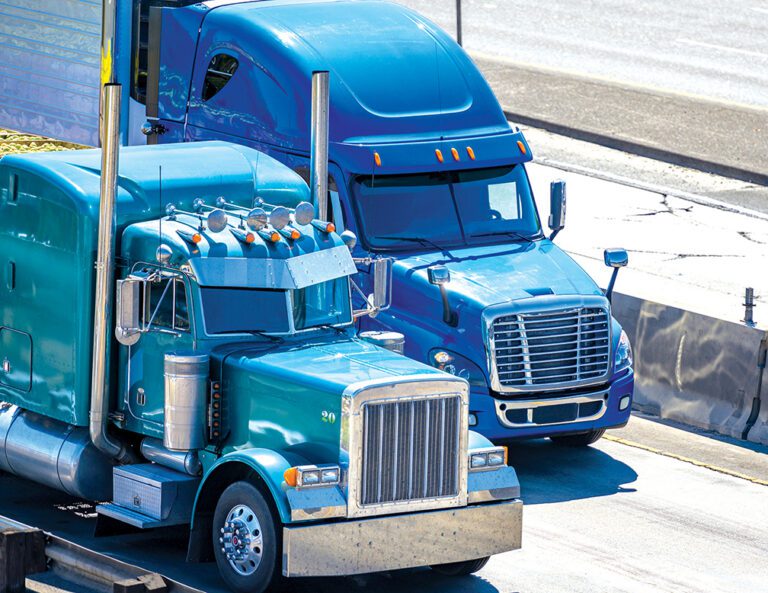The bottom. That’s what trucking industry freight forecasters are claiming has been reached. The DAT Truckload Volume Index for June was titled “June signals that spot rates have hit bottom.” The Cass Freight Index press release used “Bouncing along the bottom.” At ACT Research, the chosen title was “US freight market bouncing along the cycle bottom.”
Truckers who depend on the spot freight market for most (or all) of the loads they haul might be comforted by the thought that this should be as bad as it gets. That’s small consolation, however, to those who have had to shut down equipment, laid off drivers or closed their doors, in part due to poor freight rates.
The Cass Freight Index for Shipments reported June shipment numbers dropped 1.6% from May, which works out to 1.9% when seasonally adjusted. Year over year, shipment numbers dropped by 4.7%, and by 6.8% over the past two years.
The Cass Freight Index for Expenditures, the amount spent for all shipments, declined by 2.6% in June and by a whopping 24.5% from June 2022 expenditures. Obviously, when there are fewer shipments, the total amount of money spent on them will also decline. However, when the number of shipments drops and the cost per shipment also drops, the negative numbers get worse.
The Cass release specifies declining retail sales and ongoing destocking as the “primary headwinds. The good news,
according to the Cass report, is that the economy is coming out of the worst of it. The report also states the current downcycle saw its first decline 18 months ago. That’s significant when we consider that the past three downcycles have lasted 21 to 28 months. The implication, of course, is that we’re getting close to the beginning of the next upcycle for freight rates.
It’s important to note that, although expenditures have fallen from the historic high point achieved mid-last year, they have not fallen below rates in the first third of 2021 — and they are still higher than the years prior. Unfortunately, expenses are also up, so all is relative.
The Cass Indexes for Shipments and Expense are calculated from billing information Cass processes for its customers and represents multiple modes of transportation, including truckload and less-than-truckload shipping, rail, parcel, pipeline and more. Trucking comprises more than half of the dollars spent.
“The volume downturn appears to be in the later innings and, after a long soft patch, we see the U.S. freight transportation industry on the cusp of a new cycle,” said Tim Denoyer, vice president and senior analyst at ACT Research, who writes the Cass report.
Denoyer is referring to the Classic Truckload Cycle that shows the correlation between truck sales, rates and shipment volumes. A new cycle begins as the market adjusts to lower freight volumes by shedding trucks, reducing the supply of available transportation to the demand of shipment numbers. The current, “bottoming” cycle hits full swing when the number of available trucks exceeds available freight, driving competition for freight up and rates down.
The nontypical part of the cycle picture now is that truck sales numbers are still high, but orders for more new trucks have slowed and more used trucks are hitting the market as carriers trade or turn in equipment.
ACT Research’s June Freight and Transportation Forecast pointed out two related statistics for June. The U.S. Bureau of Labor Statistics reported employment of long-distance drivers is increasing in 2023. At the same time, the U.S. Department of Transportation is reporting record numbers of authority revocations for the same period. Clearly, many drivers and carriers who purchased trucks to take advantage of rising spot freight rates two years ago have sold those trucks or let them go to the financing authority and re-entered the labor market. Fewer owner-operators equals more company drivers.
DAT, the country’s largest load board, reported freight volumes and spot rates for loads held firm in June while contract rates continued to fall, reaching their lowest point in almost two years.
“The gap between spot and contract rates was the narrowest since April 2022,” said Ken Adamo, chief of analytics for DAT. “Rates for van and refrigerated freight increased for the third straight month, and volumes were almost unchanged from May. These are signs that spot truckload prices have reached the bottom of the current freight cycle.”
DAT reported van spot rates rose by an average of three cents per mile. That’s the first increase in five months. Spot refrigerated rates also rose by three cents per mile, while flatbed rates declined by two cents. Keep in mind that averages are just that — averages — and rates in some areas may have risen more while declining in other areas.
One potential boon for the truckload industry could be the labor strife between the Teamsters union and UPS. As of this writing, a strike is expected. Should it occur, UPS may need to hire carriers to continue some of its linehaul operations, adding loads to the system. As those loads tie up some of the available equipment, spot rates for other loads could rise as competition becomes lower. However, there is no way to predict how large the impact of a UPS strike might be.
Adamo addressed this in the DAT report, saying, “Demand for truckload services typically slows at this time of year, but this could change quickly given the threat of strikes in the parcel and less-than-truckload sectors. Shippers are putting contingency plans in place and would look to freight brokers and carriers on the spot market to keep their line haul operations moving. Demand for trucks would jump, especially around Louisville, Memphis, Indianapolis, Dallas and other major parcel hubs.”
Kenny Vieth, ACT’s president and senior analyst, predicts improvements in the near future.
“The upward forecast revisions reflect our view that macroeconomic positives will increasingly outweigh negatives as the calendar advances into 2024,” Vieth said. “Next year inventory accumulation should inflect to a freight tailwind, from the current destocking headwind.”
Clearly, analysts believe the U.S. freight market is poised to begin an upward trend. Exactly when that will happen is up for debate, but there should be some comfort in the thought that things won’t get worse.
Cliff Abbott is an experienced commercial vehicle driver and owner-operator who still holds a CDL in his home state of Alabama. In nearly 40 years in trucking, he’s been an instructor and trainer and has managed safety and recruiting operations for several carriers. Having never lost his love of the road, Cliff has written a book and hundreds of songs and has been writing for The Trucker for more than a decade.







